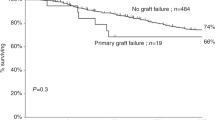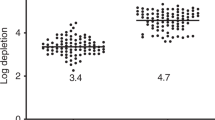Abstract
Twenty-one paediatric patients (11 males and 10 females) received a CD34-selected partially matched related donor transplant for malignant (16 cases) and non-malignant conditions (five cases). The average cell dose was 11.13 × 106/kg. Fifteen of 16 patients with malignant conditions and one with non-malignant disease received total body irradiation plus cyclophosphamide. Three of 5 patients with non-malignant conditions and one with leukaemia, received busulphan plus cyclophosphamide. One patient with Fanconi anaemia received 100 mg/kg of cyclophosphamide. Fludarabine (25 mg/m2/day for 5 days) was administered prior to all these regimens. Additionally, anti-lymphocyte gamma-globulin (12.5 mg/kg/day) was administered from day −2 to day +2. Three (15%) patients failed to achieve complete chimaerism (CC). These patients received a second cell infusion. Two of them achieved CC. In the third patient, the percentage of donor cells was increased. The likelihood for engraftment was not related to the cell dose received. Acute graft-versus-host disease (GVHD) occurred in nine patients but only one developed GVHD >grade II. Eight patients developed active viral infections, which resolved after treatment. Patients receiving cell doses higher than our average had a significantly faster CD3 and CD4 cell recovery and experienced a lower incidence of viral infections. After 480 ± 255 days of median follow-up, 16/21 patients are alive and well and have CC. Three patients died of leukaemic relapse and a fourth from progression of his disease (adreno-leuko-dystrophy). We conclude that partially matched related donors are a feasible source of haemopoietic progenitor cells for transplantation for patients without matched familial or unrelated donors.
This is a preview of subscription content, access via your institution
Access options
Subscribe to this journal
Receive 12 print issues and online access
$259.00 per year
only $21.58 per issue
Buy this article
- Purchase on Springer Link
- Instant access to full article PDF
Prices may be subject to local taxes which are calculated during checkout

Similar content being viewed by others
References
Dini G, Cornish JM, Gadner H et al. Bone marrow transplant indications for childhood leukemias: achieving a consensus. The EBMT Pediatric Diseases Working Party Bone Marrow Transplant 1996 18 (Suppl. 2): S4 7
Speiser DE, Hermans J, van Biezen A et al. Haploidentical family member transplants for patients with chronic myeloid leukaemia: a report of the Chronic Leukaemia Working Party of European Group for Blood and Marrow Transplantation (EBMT) Bone Marrow Transplant 1997 19: 1197 1203
Nagler A, Brautbar C, Slavin S, Bishara A . Bone marrow transplantation using unrelated and family related donors: the impact of HLA-C disparity Bone Marrow Transplant 1996 18: 891 897
Polchi P, Lucarelli G, Galimberti M et al. Haploidentical bone marrow transplantation from mother to child with advanced leukemia Bone Marrow Transplant 1995 16: 529 535
Passweg JR, Kuhne T, Gregor M et al. Increased stem cell dose, as obtained using currently available technology, may not be sufficient for engraftment of haploidentical stem cell transplants Bone Marrow Transplant 2000 26: 1033 1036
Kawano Y, Takaue Y, Watanabe A et al. Partially mismatched pediatric transplants with allogeneic CD34(+) blood cells from a related donor Blood 1998 92: 3123 3130
Henslee-Downey PJ, Abhyankar SH, Parrish RS et al. Use of partially mismatched related donors extends access to allogeneic marrow transplant Blood 1997 89: 3864 3872
Henslee-Downey PJ . Mismatched bone marrow transplantation Curr Opin Oncol 1995 7: 115 121
Peters C, Matthes-Martin S, Fritsch G et al. Transplantation of highly purified peripheral blood CD34+ cells from HLA-mismatched parental donors in 14 children: evaluation of early monitoring of engraftment Leukemia 1999 13: 2070 2078
Veys PA, Meral A, Hassan A et al. Haploidentical related transplants and unrelated donor transplants with T cell addback Bone Marrow Transplant 1998 21 (Suppl. 2): S42 44
Bunjes D, Duncker C, Wiesneth M et al. CD34+ selected cells in mismatched stem cell transplantation: a single centre experience of haploidentical peripheral blood stem cell transplantation Bone Marrow Transplant 2000 25 (Suppl. 2): S9 11
Handgretinger R, Schumm M, Lang P et al. Transplantation of megadoses of purified haploidentical stem cells Ann NY Acad Sci 1999 872: 351 361
Ortin M, Passant M, Saul P, Darbyshire PJ . Fludarabine-based conditioning regimes for related haploidentical stem-cell transplantation Bone Marrow Transplant 2000 25 (Suppl. 1): S34
Kapelushnik J, Mandel H, Varadi G, Nagler A . Fludarabine-based protocol for haploidentical peripheral blood stem cell transplantation in Hurler syndrome J Pediatr Hematol Oncol 2000 22: 433 436
Klingebiel TE, Lang P, Schumm M et al. Current results in haploidentical stem cell transplantation in children Bone Marrow Transplant 2000 25 (Suppl. 1): S1
Huang P, Chubb S, Plunkett W . Termination of DNA synthesis by 9-β-D-arabinofuranosyl-2-fluoroadenine: a mechanism for cytotoxicity J Biol Chem 1990 265: 16617 16625
Giralt S, Estey E, Albitar M et al. Engraftment of allogeneic hematopoietic progenitor cells with purine analog-containing chemotherapy: harnessing graft-versus-leukemia without myeloablative therapy Blood 1997 89: 4531 4536
Slavin S, Nagler A, Naparstek E et al. Nonmyeloablative stem cell transplantation and cell therapy as an alternative to conventional bone marrow transplantation with lethal cytoreduction for the treatment of malignant and nonmalignant hematologic diseases Blood 1998 91: 756 763
Dokal IS, Roberts IA . Bone marrow transplantation for Fanconi's anaemia: conditioning with reduced doses of cyclophosphamide without radiation Br J Haematol 1996 94: 423
Aversa F, Martelli MM, Reisner Y . Use of stem cells from mismatched related donors Curr Opin Hematol 1997 4: 419 422
Reisner Y, Martelli MF . Transplantation tolerance induced by ‘mega dose’ CD34+ cell transplants Exp Hematol 2000 28: 119 127
Gandy KL, Domen J, Aguila H, Weissman IL . CD8+TCR+ and CD8+TCR− cells in whole bone marrow facilitate the engraftment of hematopoietic stem cells across allogeneic barriers Immunity 1999 11: 579 590
Bader P, Beck J, Schlegel PG et al. Additional immunotherapy on the basis of increasing mixed hematopoietic chimerism after allogeneic BMT in children with acute leukemia: is there an option to prevent relapse? Bone Marrow Transplant 1997 20: 79 81
Nagler A, Ackerstein A, Or R et al. Adoptive immunotherapy with haploidentical allogeneic peripheral blood lymphocytes following autologous bone marrow transplantation Exp Hematol 2000 28: 1225 1231
Bowers E, Tamaki S, Coward A et al. Differing functional recovery of donor-derived immune cells after purified haploidentical and fully mismatched hematopoietic stem cell transplantation in mice Exp Hematol 2000 28: 1481 1489
Gross TG, Steinbuch M, DeFor T et al. B cell lymphoproliferative disorders following hematopoietic stem cell transplantation: risk factors, treatment and outcome Bone Marrow Transplant 1999 23: 251 258
Ruggeri L, Capanni M, Casucci M et al. Role of natural killer cell alloreactivity in HLA-mismatched hematopoietic stem cell transplantation Blood 1999 94: 333 339
Henslee-Downey PJ . Haploidentical transplantation Cancer Treat Res 1999 101: 53 77
Acknowledgements
We would like to acknowledge Dr S Meller and Prof CR Pinkerton for their critical review of this article.
Author information
Authors and Affiliations
Rights and permissions
About this article
Cite this article
Ortín, M., Raj, R., Kinning, E. et al. Partially matched related donor peripheral blood progenitor cell transplantation in paediatric patients adding fludarabine and anti-lymphocyte gamma-globulin. Bone Marrow Transplant 30, 359–366 (2002). https://doi.org/10.1038/sj.bmt.1703667
Received:
Accepted:
Published:
Issue Date:
DOI: https://doi.org/10.1038/sj.bmt.1703667
Keywords
This article is cited by
-
Prognostic factors and outcomes for pediatric patients receiving an haploidentical relative allogeneic transplant using CD3/CD19-depleted grafts
Bone Marrow Transplantation (2016)
-
Improved immune recovery after transplantation of TCRαβ/CD19-depleted allografts from haploidentical donors in pediatric patients
Bone Marrow Transplantation (2015)
-
Haploidentical SCT in children: an update and future perspectives
Bone Marrow Transplantation (2008)
-
Rituximab mediates in vitro antileukemic activity in pediatric patients after allogeneic transplantation
Bone Marrow Transplantation (2005)
-
Effective donor lymphohematopoietic reconstitution after haploidentical CD34+-selected hematopoietic stem cell transplantation in children with refractory severe aplastic anemia
Bone Marrow Transplantation (2004)



